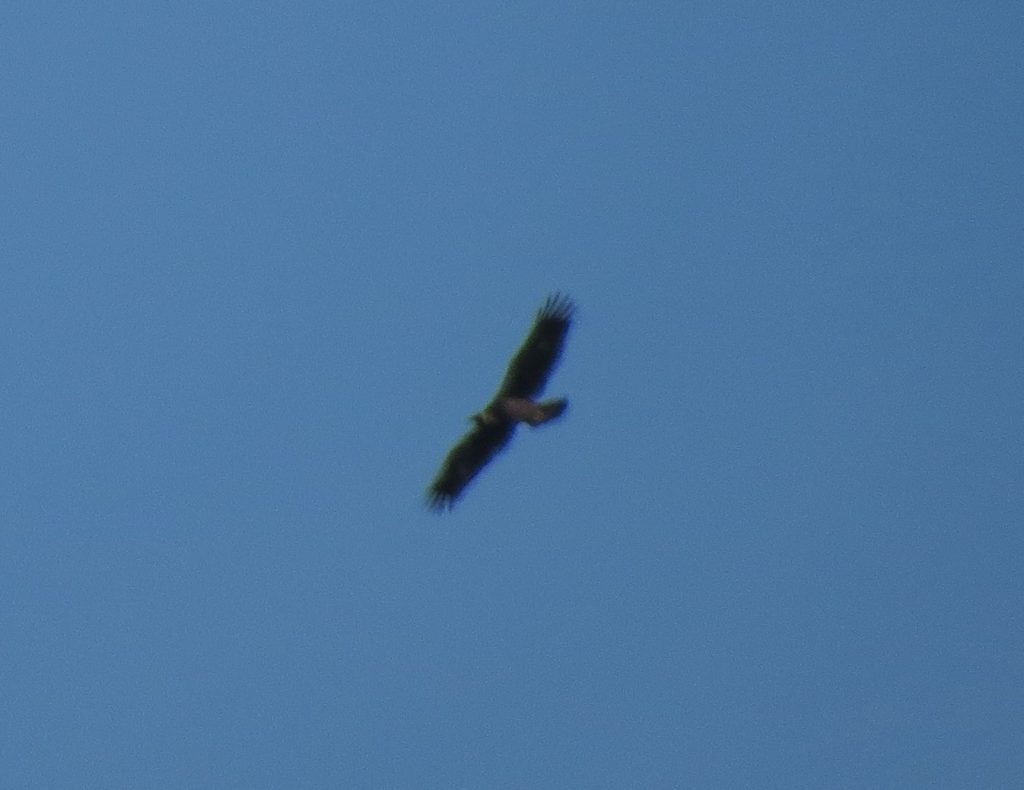On February 25, 2015, I was working outside on some property near the North Umpqua Highway between Roseburg and Glide, north of Dixonville. At about noon I took some time to look around and listen and have some lunch. To the east I could see four ravens harassing an eagle, so I got out my bins and camera. With my binoculars I could see that the bird being pestered was an immature Golden Eagle: large pale area to base of tail, pale areas–though subtle–at base of primaries, and small head with golden hackles. This interaction among ravens and Golden Eagles is fairly common in this area, but I continue to enjoy trying to capture it in photos and video (below).
Moments later an immature Bald Eagle was soaring in the same vicinity and I shot some photos of that bird as well. With the birds moving around it was hard to keep track of which eagle or raven I was following. After “shooting” for a while, I looked at some of the images on my camera screen. The shots were all distant, handheld, and fuzzy, but that is one of the challenges in birding: identifying birds at great distance by shape and other subtle clues. Then, …one of the images caught my eye… “What is this?” I asked myself. That looks a lot like an immature California Condor! Look at that neck hanging down there, and that small dark head and bill!!! Did I miss this bird, being too focused on just getting some photos? ….I looked around again over the ridge…, nothing…. “I should check my before and after images,” I thought. …These showed the bird as it progressed through its soaring flight. It was not a different bird, it was just the immy Golden Eagle I had been photographing.
So, what’s up with the bird in this photo? Why does it have the look of a condor? Well, if you have ever watched ravens harassing an eagle, and watched the eagle, you will see the eagle looking around, moving its head and neck in various directions, up over its back, under this wing, that wing, turning its head this way and that, depending on where its attackers are. It appears that this particular image caught this immy Golden Eagle as it was looking up and to its right, with its head turned back that direction a bit, … and its head and neck were “hunched” down because, as you can see in the following photo (and video above), there were four ravens attempting to whack it on the head! I would duck too!
Following are two photos which were subsequent images of the same bird within seconds of the photo above (and lightened more). In the first photo below it still looks like it has a small head, which Golden Eagles do, compared to Bald Eagles, but perhaps this bird has been hit on the back of the head and neck a few times recently (see video), reducing the fluff on its head and neck. You can begin to see the white patches at the base of the primaries and base of the tail.
To have a little fun, I sent the condor-like photo to Oregon Birder’s On Line (OBOL), letting them know I was going to have a little fun with this. The responses were what I had hoped for and understandable: “… could it be??? … a condor???” “Perhaps it escaped from Wildlife Safari…?” Others gave other opinions, including Golden Eagle, and another pointed out the “brown” belly that would probably be black on an immature condor, and the lack of any visible pale line on the underwing coverts one would expect on a condor. But that hanging head and seemingly small dark beak!
I also, in passing, sent it to a friend and colleague in Corvallis. I made sure to write that this was an immature Golden Eagle. I didn’t want to start any rumors! Unfortunately, the email was not read completely and the photo was sent to a number of people, including the chief of condor research in California for his opinion! His response? “That’s a pretty fuzzy photo.” 🙂
Just to set the record straight for good: the photo I presented was in fact, an immature Golden Eagle with a goofy (protective) neck/head posture. Because the photo was fuzzy/grainy because of the great distance, and backlit by the bright sky, essential details were obscured that would have made the identity obvious.
I hope to someday see and well-document a real California Condor here in the Umpqua Valleys, the area of the last known Condors in Oregon, near Drain, in 1903 and 1904.





This Post Has 0 Comments
Thoroughly enjoyed it Matt. Had to lol when you sent it to your Corvallis friend and he sent it on to the Condor expert!
That was fun, Matt. Your photo encouraged me to read up a bit on condors (that ID was my first impression, too) – a good thing. Thanks! Jay
Matt, congratulations on joining the blog world. I am looking forward to checking back on a regular basis. Jim
It's always a good thing when a bird makes us do a double take.